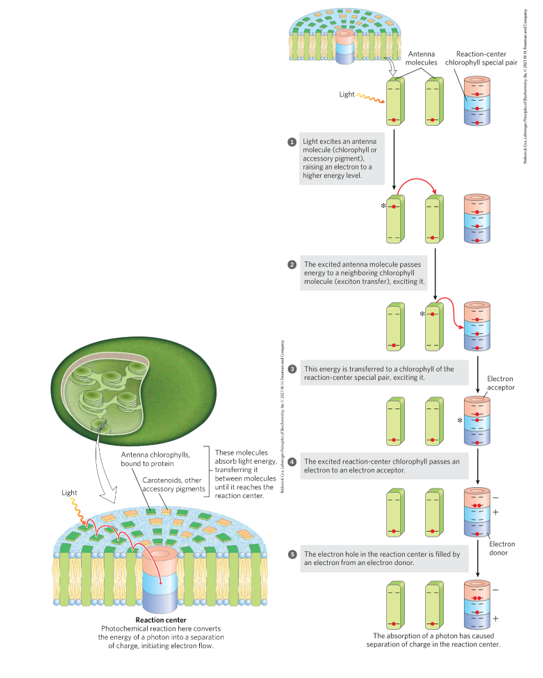Be familiar with light absorption at depth in 20.1.
Photosynthesis requires the input of energy in the form of light to create a good electron donor (H2O) and acceptor (NADP+).
Chlorophyll molecules are green pigments with polycyclic structures in thylakoid membranes. It shows strong absorption in the visible region of the spectrum; they have high molar extinction coefficients and can absorb light well. Chlorophyll a and b have different absorption spectra that complement each other's range of light absorption for more visible light absorption.
1. Energy from a photon of light is absorbed by the molecule chlorophyll, then exciton transferred to neighboring chlorophyll until it is transferred to chlorophyll of a reaction center pair.
2. The reaction center passes an electron to the electron acceptor, creating a hole that is filled by an electron from an electron donor.
Be able to describe how light energy is funneled into the reaction center

Chlorophyll funnel energy absorbed to the reaction center by exciton transfer. The photosystems are made light absorbing pigments arranged next to eachother. Only one pair of chlorophyll molecules associated with the system transduce light into chemical energy. Antenna chlorophylls bound to proteins and carotenoids and other accessory pigments absorb light energy, transferring it between molecules until it reaches the reaction center. The excited antenna transfer energy to the reaction center, exciting it, which in turn passes an electron the electron acceptor. The electron hole in the reaction center is filled by an electron from the electron donor. This charge seperation initiates an oxidation-reduction chain.
Describe photosynthesis in detail as laid out in 20-14 and 20-16
Electron transfers through photosystem II D1 subunit. Mn4CaO5 cofactor of the oxygen-evolving complex to plastiquinone b. Plastiquinone B